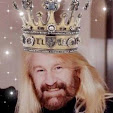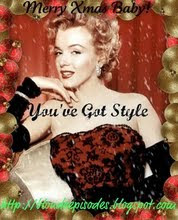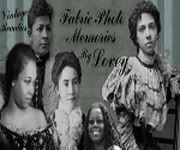In 1920 a series of photos of fairies captured the attention of the
world. The photos had been taken by two young girls, the cousins Frances
Griffith and Elsie Wright, while playing in the garden of Elsie's
Cottingley village home. Photographic experts examined the pictures and
declared them genuine. Spiritualists promoted them as proof of the
existence of supernatural creatures, and despite criticism by skeptics,
the pictures became among the most widely recognized photos in the
world.
During World War I, ten-year-old Frances Griffiths, who was from South Africa, moved into the English home of her aunt and uncle, the Wrights, while her father fought in the war. She and her cousin, thirteen-year-old Elsie, often played together in the large garden of the family's Cottingley village home.
In July 1917 the pair asked to borrow the camera of Elsie's father, telling him they wanted to take a photo of the fairies they had been playing with all morning. Elsie's father laughingly agreed and showed them how to use the camera. An hour later the girls returned, declaring their project a success. And when Mr. Wright developed the plate that evening, he could see that there did indeed appear to be a fairy posing with Frances in the photo. However, he dismissed the girls' explanation, assuming the picture was some kind of trick. He asked Elsie why there appeared to be "bits of paper" in the photo.
The first of the five Cottingley faery photos
Even when the girls took a second photo a little over a month later,
showing Elsie with a gnome, the father treated the images as a joke and
filed them away.
The second of the five Cottingley faerie photos
However, Elsie's mother, Polly Wright, had a stronger belief in the
supernatural, and was more intrigued by the photos. In 1919 she attended
a lecture on spiritualism and following it, she showed the photos to
the speaker, asking him if they "might be true after all." The speaker
brought the photos to the attention of Edward Gardner, a leader of the
Theosophical movement, who in turn asked a photographer, Harold
Snelling, to examine them. Snelling declared the photos were "genuine
unfaked photographs of single exposure, open-air work, show movement in
all the fairy figures, and there is no trace whatever of studio work
involving card or paper models, dark backgrounds, painted figures, etc."
Sir Arthur Conan Doyle
Once they had received this stamp of approval, the fairy images began
circulating throughout the British spiritualist community, and soon came
to the attention of Sir Arthur Conan Doyle, author of the Sherlock
Holmes mysteries. Doyle was a passionate believer in spiritualism, and
he latched onto the images, convinced they were conclusive photographic
proof of the existence of supernatural fairy beings.
At Doyle's urging, the girls took three more pictures of fairies in
August 1920. Doyle then wrote an article about the photographs that
appeared in the December 1920 issue of The Strand Magazine, in
which he passionately argued for the authenticity of the images. This
article brought the photos to the attention of the wider public and
sparked an international controversy that pitted spiritualists against
skeptics.
#1. Frances and the Fairies. Taken July 1917. Camera: Midg
Quarter. "The negative was a little over-exposed. The waterfall and
rocks are about 20 feet distance behind Frances, who is standing in
shallow water inside the bank of the beck. The colouring of the fairies
was described by the girls as shades of green, lavender and mauve, most
marked in the wings and fading to almost pure white in the limbs and
drapery."
THE PHOTOS
Shown below are the five Cottingley fairy photos, in the order in which
they were taken. The text of the accompanying descriptions comes from Fairies: The Cottingley Photographs and Their Sequel by Edward Gardner (published 1945).
#2. Elsie and the Gnome. Taken September 1917. Camera: Midg
Quarter. "Elsie was playing with the gnome and beckoning it to come on
to her knee. The gnome leapt up just as Frances, who had the camera,
snapped the shutter. He is described as wearing black tights, a reddish
jersey and a pointed bright red cap. Elsie said there was no perceptible
weight, though when on the bare hand the feeling is like a 'little
breath'. The wings were more moth-like than the fairies and of a soft
neutral tint. Elsie explained that what seem to be markings on his wings
are simply his pipes, which he was swinging in his grotesque little
left hand."
#3. Frances and the Leaping Fairy. Taken August 1920. Camera:
Cameo Quarter. "The fairy is leaping up from the leaves below and
hovering for a moment—it had done so three or four times. Rising a
little higher than before, Frances thought it would touch her face, and
involuntarily tossed her head back. The fairy's light covering appears
to be close fitting: the wings were lavender in colour."
#4. Fairy Offering a Posy to Elsie. Taken August 1920. Camera:
Cameo Quarter. "The fairy is standing almost still, poised on the bush
leaves. The wings were shot with yellow. An interesting point is shown
in this photograph: Elsie is not looking directly at the sprite. The
reason seems to be that the human eye is disconcerting. If the fairy be
actively moving it does not matter much, but if motionless and aware of
being gazed at then the nature-spirit will usually withdraw and
apparently vanish. With fairy lovers the habit of looking at first a
little sideways is common."
#5. Fairies and Their Sun-Bath. Taken August 1920. Camera: Cameo
Quarter. "This is especially remarkable as it contains a feature quite
unknown to the girls. The sheath or cocoon appearing in the middle of
the grasses had not been seen by them before, and they had no idea what
it was. Fairy observers of Scotland and the New Forest, however, were
familiar with it and described it as a magnetic bath, woven very quickly
by the fairies and used after dull weather, in the autumn especially.
The interior seems to be magnetised in some manner that stimulates and
pleases."
THE CONTROVERSY
Skeptics noticed many problems with the photos, in addition to the
obvious one that the fairies look like bits of paper. For instance, in
the first photo why is Frances not looking at the fairies? (The girls
claimed they were so used to the fairies that they often paid them no
attention.) And why does the second fairy from the left not have wings?
In the second photo, why is Elsie's hand bizarrely elongated? (Frances
attributed this to "camera slant.") In the fourth photo, why is the
fairy dressed in the latest French fashions?
Despite these problems, the photos continued to attract believers. Much
of this belief might be attributed to the context of the times. By the
end of World War One the English were emotionally bruised and battered
by four years of unrelenting bloodshed. They seemed to be in need of
something that would reaffirm their belief in goodness and innocence.
They found this reaffirmation in the fairy photographs of Frances and
Elsie.
DEBUNKED
It was not until 1978 that James Randi pointed out that the fairies in
the pictures were very similar to figures in a children's book called Princess Mary's Gift Book, which had been published in 1915 shortly before the girls took the photographs.
Subsequently, in 1981, Elsie Wright confessed to Joe Cooper, who interviewed her for The Unexplained magazine, that the fairies were, in fact, paper cutouts. She explained that she had sketched the fairies using Princess Mary's Gift Book as inspiration. She had then made paper cutouts from these sketches, which she held in place with hatpins. In the second photo (of Elsie and the gnome) the tip of a hatpin can actually be seen in the middle of the creature. Doyle had seen this dot, but interpreted it as the creature's belly button, leading him to argue that fairies give birth just like humans!
Subsequently, in 1981, Elsie Wright confessed to Joe Cooper, who interviewed her for The Unexplained magazine, that the fairies were, in fact, paper cutouts. She explained that she had sketched the fairies using Princess Mary's Gift Book as inspiration. She had then made paper cutouts from these sketches, which she held in place with hatpins. In the second photo (of Elsie and the gnome) the tip of a hatpin can actually be seen in the middle of the creature. Doyle had seen this dot, but interpreted it as the creature's belly button, leading him to argue that fairies give birth just like humans!
Below is a side-by-side comparison of the figures in Princess Mary's Gift Book and the fairies in the first Cottingley fairy photo.
In 1983, the cousins admitted in an article published in the magazine The Unexplained that the photographs had been faked, although both maintained that they
really had seen fairies. Elsie had copied illustrations of dancing
girls from a popular children's book of the time, Princess Mary's Gift Book, published in 1914, and drew wings on them.They said they had then cut out the cardboard figures and supported them with hatpins, disposing of their props in the beck once the photograph had been taken. But the cousins disagreed about the fifth and final photograph, which Doyle in his The Coming of the Fairies described in this way:
In a 1985 interview on Yorkshire Television's Arthur C. Clarke's World of Strange Powers, Elsie said that she and Frances were too embarrassed to admit the truth after fooling Doyle, the author of Sherlock Holmes: "Two village kids and a brilliant man like Conan Doyle – well, we could only keep quiet." In the same interview Frances said: "I never even thought of it as being a fraud – it was just Elsie and I having a bit of fun and I can't understand to this day why they were taken in – they wanted to be taken in."
Seated on the upper left hand edge with wing well displayed is an undraped fairy apparently considering whether it is time to get up. An earlier riser of more mature age is seen on the right possessing abundant hair and wonderful wings. Her slightly denser body can be glimpsed within her fairy dress.Elsie maintained it was a fake, just like all the others, but Frances insisted that it was genuine. In an interview given in the early 1980s Frances said:
It was a wet Saturday afternoon and we were just mooching about with our cameras and Elsie had nothing prepared. I saw these fairies building up in the grasses and just aimed the camera and took a photograph.Both Frances and Elsie claimed to have taken the fifth photograph. In a letter published in The Times newspaper on 9 April 1983, Geoffrey Crawley explained the discrepancy by suggesting that the photograph was "an unintended double exposure of fairy cutouts in the grass", and thus "both ladies can be quite sincere in believing that they each took it".
In a 1985 interview on Yorkshire Television's Arthur C. Clarke's World of Strange Powers, Elsie said that she and Frances were too embarrassed to admit the truth after fooling Doyle, the author of Sherlock Holmes: "Two village kids and a brilliant man like Conan Doyle – well, we could only keep quiet." In the same interview Frances said: "I never even thought of it as being a fraud – it was just Elsie and I having a bit of fun and I can't understand to this day why they were taken in – they wanted to be taken in."
SUBSEQUENT HISTORY
Frances died in 1986, and Elsie in 1988. Prints of their photographs of the fairies, along with a few other items including a first edition of Doyle's book The Coming of the Fairies, were sold at auction in London for £21,620 in 1998.
That same year, Geoffrey Crawley sold his Cottingley Fairy material to
the National Museum of Film, Photography and Television in Bradford (now
the National Media Museum),
where it is on display. The collection included prints of the
photographs, two of the cameras used by the girls, watercolours of
fairies painted by Elsie, and a nine-page letter from Elsie admitting to
the hoax. The glass photographic plates were bought for £6,000 by an unnamed buyer at a London auction held in 2001.
Frances' daughter, Christine Lynch, appeared in an episode of the television programme Antiques Roadshow in Belfast broadcast on BBC One in January 2009, with the photographs and one of the cameras given to the girls by Doyle. Christine told the expert, Paul Atterbury, that she believed, as her mother had done, that the fairies in the fifth photograph were genuine. Atterbury estimated the value of the items at between £25,000 and £30,000. The first edition of Frances' memoirs was published a few months later, under the title Reflections on the Cottingley Fairies. The book contains correspondence, sometimes "bitter", between Elsie and Frances. In one letter, dated 1983, Frances wrote:
I hated those photographs from the age of 16 when Mr Gardner presented me with a bunch of flowers and wanted me to sit on the platform [at a Theosophical Society meeting] with him. I realised what I was in for if I did not keep myself hidden.
Frances' daughter, Christine Lynch, appeared in an episode of the television programme Antiques Roadshow in Belfast broadcast on BBC One in January 2009, with the photographs and one of the cameras given to the girls by Doyle. Christine told the expert, Paul Atterbury, that she believed, as her mother had done, that the fairies in the fifth photograph were genuine. Atterbury estimated the value of the items at between £25,000 and £30,000. The first edition of Frances' memoirs was published a few months later, under the title Reflections on the Cottingley Fairies. The book contains correspondence, sometimes "bitter", between Elsie and Frances. In one letter, dated 1983, Frances wrote:
I hated those photographs from the age of 16 when Mr Gardner presented me with a bunch of flowers and wanted me to sit on the platform [at a Theosophical Society meeting] with him. I realised what I was in for if I did not keep myself hidden.
I don't care if the photos were real or not ... I still believe in faeries!
Now - go make something beautiful!
¸.•´¸.•*´¨) ¸.•*´¨)(¸.•´
(¸.•´♥ Tristan ♥
The photographs were parodied in a 1994 book written by Terry Jones and Brian Froud, Lady Cottington's Pressed Fairy Book.

































































































4 comments:
I remember this movie, fascinating. I love that you took the time to post this wonderful story. I do believe in fairies and I think I spotted one my garden years ago. Unfortunately I did not have my camera handy!!! Thank you Tristan!
I love Lady Cottington's Pressed Fairy Book. Also gave the calendar for Christmas.
This is one of my favorite tales, I'm sad at the debunking, because it was so delightful! Thank you for the posting, this was a lovely read!
Oh how I wanted this to be true! Oh well, at least for awhile we can imagine- and yes, I do believe in fairies- I do I do I do!
Love the new look of your blog Tristan!
Happy Easter!
hugs,Jackie
ps...thank you ever so much for your wonderful comments you leave on my blog- you really make my day! xx
Post a Comment